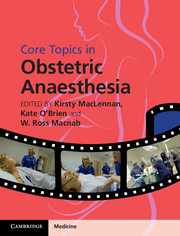Book contents
- Frontmatter
- Contents
- List of contributors
- Preface
- Section 1 Basic science, epidemiology and service organization
- 1 Physiology of pregnancy
- 2 Placental physiology
- 3 Pharmacology relevant to pregnancy
- 4 Maternal morbidity and mortality
- Section 2 Obstetric aspects
- Section 3 Provision of anaesthesia
- Section 4 Medical conditions in pregnancy
- Section 5 Postpartum complications and obstetric emergencies
- Section 6 Service organization
- Index
- Plate section
- References
4 - Maternal morbidity and mortality
from Section 1 - Basic science, epidemiology and service organization
Published online by Cambridge University Press: 05 December 2015
- Frontmatter
- Contents
- List of contributors
- Preface
- Section 1 Basic science, epidemiology and service organization
- 1 Physiology of pregnancy
- 2 Placental physiology
- 3 Pharmacology relevant to pregnancy
- 4 Maternal morbidity and mortality
- Section 2 Obstetric aspects
- Section 3 Provision of anaesthesia
- Section 4 Medical conditions in pregnancy
- Section 5 Postpartum complications and obstetric emergencies
- Section 6 Service organization
- Index
- Plate section
- References
Summary
Introduction
Until the mid-1930s maternal mortality was high in the Western world with the maternal mortality rate (MMR) about 450 per 100,000 births (UK); the current MMR is 8 per 100,000 births.
The vast majority of maternal mortality occurs in the developing world. The Millennium Development Goals is an initiative to improve maternal health in developing countries. The aim is to reduce the maternal mortality ratio by three quarters from 1990 to 2015.
National maternal mortality statistics have been recorded in the UK for over 150 years. The Maternal Death enquiries have been published every three years since 1952; this is the longest running continuous medical audit in the world. The enquiries review and assess maternal deaths and recommend service changes to make childbirth safer.
History of maternal mortality
The maternal mortality rate in England and Wales was fairly static from 1880 to the mid-1930s and the risk of dying in childbirth was the same as in the Victorian era. Mortality from infectious diseases and infant mortality started to fall in the late 1890s. This was due to an increased standard of living: better housing, hygiene and nutrition; however, this was not translated into lower rates of maternal mortality until the mid-1930s. After this there was a steep decline in maternal mortality rates, which continued for the next 50 years. This pattern was consistent throughout the developed world.
The exception was in northwestern European countries: Sweden, Norway, the Netherlands and Denmark. In these countries there were well-trained midwives who used aseptic techniques from their inception (1890–1900) and there was a tradition of minimal surgical intervention whether at home or in hospital. This led to low rates of maternal mortality.
Another success story was the midwives in the Kentucky Frontier Nursing Service. The midwives travelled on horseback to help with childbirth. Despite the fact that these women lived in poor rural communities the maternal mortality rates were ten times less than those in the city of Lexington.
Medical interference
The UK maternal mortality figures showed a significant trend upwards in the 1890s; the maximum excess of deaths was, at its worst, 250 per 100,000 births. This was in the main due to the use of chloroform and unnecessary forceps deliveries.
- Type
- Chapter
- Information
- Core Topics in Obstetric Anaesthesia , pp. 24 - 28Publisher: Cambridge University PressPrint publication year: 2015



